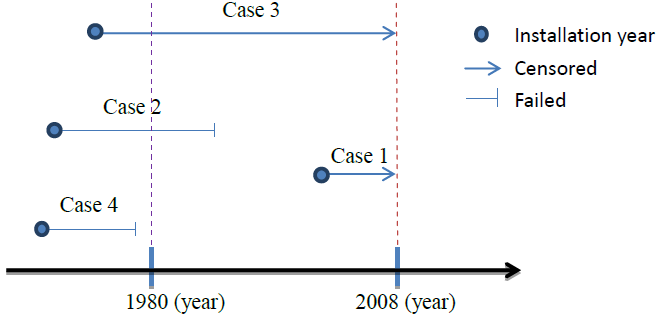A Differential Evolution Optimization Approach for Parameters Estimation of Truncated and Censored Failure Time Data
Keywords:
heuristics, truncation, censoring, maximum likelihood estimation, reliability analysisAbstract
Most practically collected datasets are plagued with issues of incompleteness and inaccuracies which will cause erroneous reliability modeling and poor maintenance decisions. This work outlines an investigation into the use of Heuristic techniques to estimate the parameters of a stochastic life distribution by using failure data with Truncation and Censoring. A Maximum Likelihood Estimation (MLE) approach was utilized in which the Log-Likelihood function is modified to account for the Truncation and Censoring factors. A Differential Evolution (DE) algorithm developed in MATLAB R2013a minimizes the Negative Log Likelihood (NLL) function and obtains optimum parameters for the 2 Parameters (2-P) Weibull distribution. Results obtained from a series of designed experimental tests generalized the relationship between the increasing levels of Truncation and Censoring individually on the β and η parameters. The impact of the modified NLL technique was examined under cases of Left Truncated and Right Censored (LTRC) data through evaluations of the MSE metric which were compared to estimations made under the normal NLL equation. Truncation and Censoring percentages were increased from 0% to 50% for testing the modified NLL approach. It is clear from the low MSE values (error) that this approach is successful at estimating the parameters closer to the true values. This approach was applied to failure data of a Gas Engine Power Generator utilized in Offshore Gas Production. The results were compared with those obtained from traditional Weibull Analysis in the ReliaSoft Weibull/Alta package.
References
A. H. C. Tsang, W. K. Yeung, A. K. S. Jardine, and B. P. K. Leung, “Data management for CBM optimization,” Journal of Quality in Maintenance Engineering, vol. 12, no. 1, pp. 37-51, 2006.
Y. Hong, “Reliability prediction based on complicated data and dynamic data,” Ph.D. dissertation, Iowa State Univ., Iowa, 2009.
A. Carrión, H. Solano, M. L. Gamiz, and A. Debón, “Evaluation of the reliability of a water supply network from right-censored and left-truncated break data,” Water Resources Management, vol. 24, no. 12, pp. 2917-2935, September 2010.
M. lopez, M. Elisa, R. Cao, and I. V. Keilegom, “Smoothed empirical likelihood confidence intervals for the relative distribution with left‐truncated and right‐censored data,” Canadian Journal of Statistics, vol. 38, no. 3, pp. 453-473, August 2010.
N. Balakrishnan and D. Mitra, “Likelihood inference based on left truncated and right censored data from a gamma distribution,” IEEE Transactions on Reliability, IEEE Press, July 2013, pp. 679-688.
B. Bhattacharya, D. L. Shrestha, and D. P. Solomatine, “Neural networks in reconstructing missing wave data in sedimentation modelling,” In Proc. 30th Congress of International Association of Hydraulic Engineering and Research (IAHR), IEEE Press, August 2003, pp. 209-216.
N. Balakrishnan and D. Mitra, “Some further issues concerning likelihood inference for left truncated and right censored lognormal data,” Communications in Statistics-Simulation and Computation, vol. 43, no. 2, pp. 400-416, May 2013.
G. D. Maringer, Portfolio management & heuristic optimization, 2nd ed. New York: Springer US, 2006.
T. Emura and S. K. Shiu, “Estimation and model selection for left-truncated and right-censored lifetime data with application to electric power transformers analysis,” Communications in Statistics-Simulation and Computation, IEEE Press, March 2016, pp. 3171-3189.
J. Liu, “Analyzing left-truncated right-censored data with uncertain onset time with parametric models,” Ph.D. dissertation, The University of Texas School of Public Health, 2012.
D. Mitra, “Likelihood inference for left truncated and right censored lifetime data,” Ph.D. Dissertation, Mc Master Univ., 2013.
X. L. Dong, S. Q. Liu, T. Tao, S. P. Li, and K. L. Xin, “A comparative study of differential evolution and genetic algorithms for optimizing the design of water distribution systems,” Journal of Zhejiang University Science A, vol. 13, no. 9, pp. 674-686, September 2012.
R. Storn and K. Price, “Differential evolution-a simple and efficient heuristic for global optimization over continuous spaces,” Journal of global optimization 11, vol. 11, no. 4, pp. 341-359, December 1997.
J. Tvrdik, “Competitive differential evolution and genetic algorithm in GA-DS toolbox,” Technical Computing Prague, Humusoft Press, 2006, pp. 99-106.
D. Karaboga and S. Ökdem, “A simple and global optimization algorithm for engineering problems: differential evolution algorithm,” Turkish Journal of Electrical Engineering & Computer sciences, January 2004, pp. 53-60.
D. Swagatam, S. S. Mullick, and P. N. Suganthan, “Recent advances in differential evolution-an updated survey,” Swarm and Evolutionary Computation, vol. 27, pp. 1-30, April 2016.
W. Ling and F. Huang, “Parameter analysis based on stochastic model for differential evolution algorithm,” Applied Mathematics and Computation, vol. 217, no. 7, pp. 3263-3273, December 2010.
F. S. Lobato, V. Steffen Jr, and S. N. J. Antônio, “A comparative study of the application of differential evolution and simulated annealing in radiative transfer problems,” Journal of the Brazilian Society of Mechanical Sciences and Engineering, vol. 32, pp. 518-526, December 2010.
F. W. Scholz, “Maximum likelihood estimation,” Encyclopedia of statistical sciences, John Wiley and Sons, Inc., 1985.
R. B. Abernethy, The new weibull handbook, 2nd ed. Texas: Barringer & Associates, 2006.

Published
How to Cite
Issue
Section
License
Submission of a manuscript implies: that the work described has not been published before that it is not under consideration for publication elsewhere; that if and when the manuscript is accepted for publication. Authors can retain copyright in their articles with no restrictions. is accepted for publication. Authors can retain copyright of their article with no restrictions.
Since Jan. 01, 2019, AITI will publish new articles with Creative Commons Attribution Non-Commercial License, under The Creative Commons Attribution Non-Commercial 4.0 International (CC BY-NC 4.0) License.
The Creative Commons Attribution Non-Commercial (CC-BY-NC) License permits use, distribution and reproduction in any medium, provided the original work is properly cited and is not used for commercial purposes.



